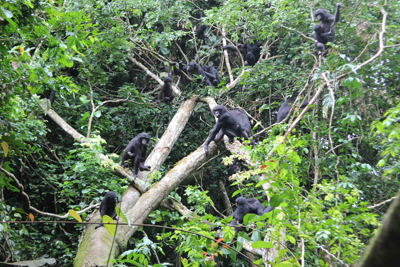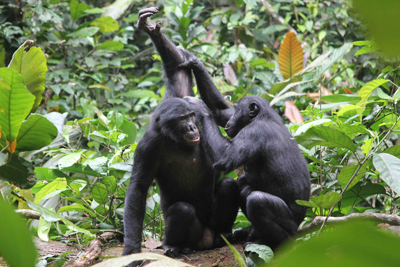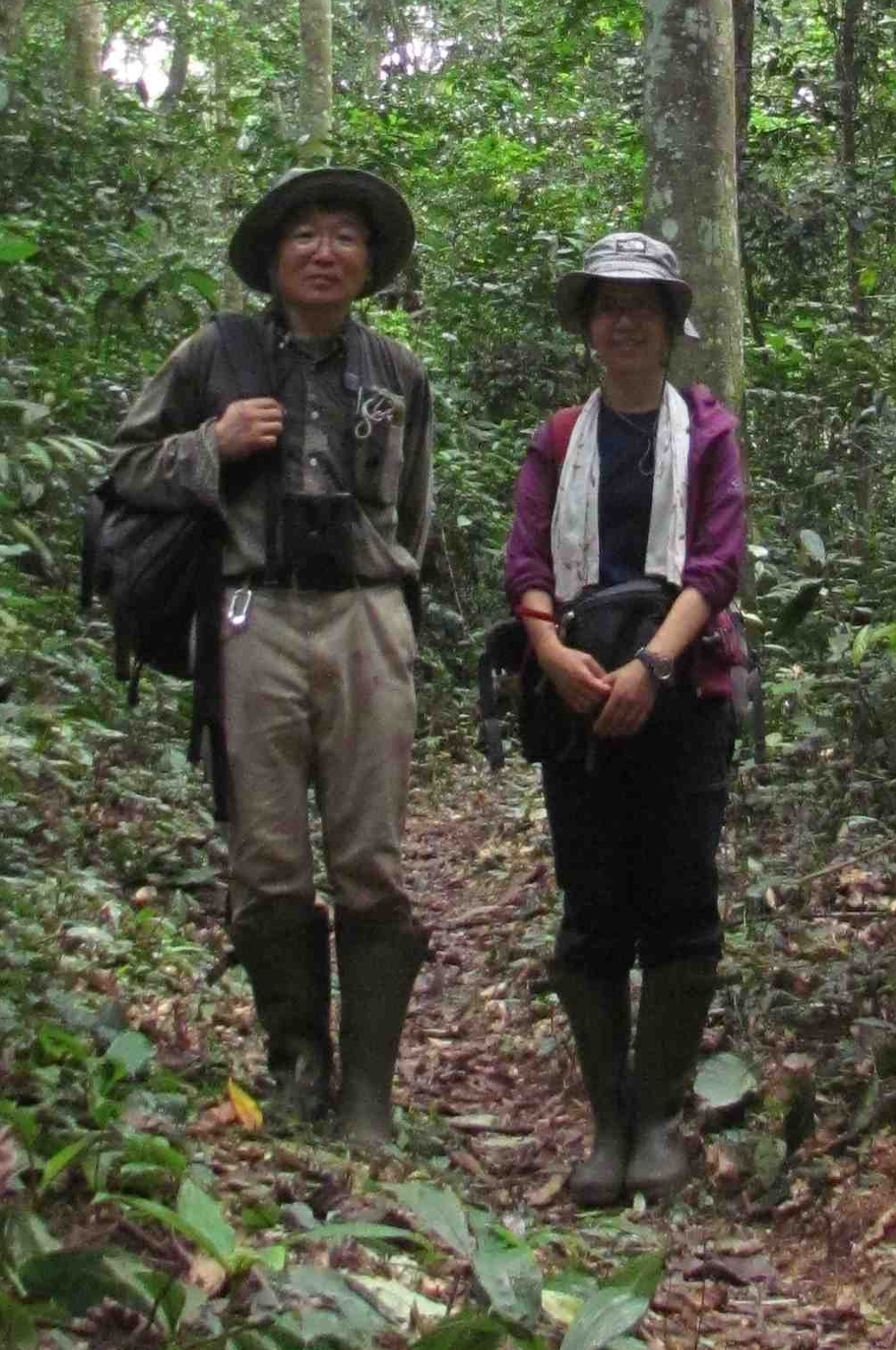Biodiversity and Primates
- Takakazu Yumoto
- Professor, Research Institute for Humanity and Nature, Kyoto University
President, Association of Wildlife and Human Society
Introduction

The word primate encompasses a wide range of species, from the nocturnal galago and tarsier weighing less than 100 grams, to the gorilla, chimpanzee, bonobo, and human of the Hominidae family. Some gorillas and humans will weigh more than 200 kilograms. The heaviest person on record, by the way, weighed 560 kilograms, according to Guinness World Records. We could say he was the heaviest primate in all of recorded and unrecorded history. In addition to size, primates also show various differences in diet and social organization, a fact that has been a significant motivation behind comparative primate research.
Omnivorous Diet
In mammal studies, teeth are useful in understanding what an animal eats. Herbivores such as horses and cows have molars for grinding, while carnivores such as lions and wolves have canine teeth for cutting. In the case of primates, which make use of both molars and canines, their teeth are multifunctional and suited to omnivorous diets. It is true that some species of smaller primates eat mainly insects; and that others, like the colobus, are specialized leaf-eaters; while others still, such as saki monkeys in South America, rely on a diet of seeds. In general, however, primates are distinctive for the wide range of forest foods that they eat, from leaves, fruits, and seeds, to insects and mushrooms. The crab-eating macaque that inhabits coastal areas of Asia eats not only typical primate foods such as leaves and fruit; as its name suggests, it is known for also eating crustaceans, shellfish and sometimes fish. The Japanese macaque too eats seaweed and shellfish in particular regions and seasons.
Fruit is a favorite food of many primates. For chimpanzees and bonobos in the tropical forests of Africa, and also orangutans and gibbons in those of Southeast Asia, fruit is the food of choice. Likewise, the gorillas that share the same tropical forests with chimpanzees prefer fruit during seasons when ripe fruit is plentiful; unlike chimpanzees, however, which will travel long distances in search of fruit, gorillas will shift to eating herbaceous plants that grow on the forest floor during periods when fruit is scare. In the mountainous regions where the fruits are less abundant at the eastern edge of the Congo Basin, mountain gorillas survive on a daily diet of herbaceous plants that includes thistles and nettles.
Previously, as I tracked a troop of Yakushima macaques, I learned that the macaques spend their time searching for different foods, one after another. The primates spend their time continually relocating, eating, and resting from the time they awake in the morning until they sleep at night. June is the season for yamamomo (Myrica rubra), a sweet fruit that is a macaque favorite and tastes delicious even to us. It would be wrong to assume that the macaques eat nothing else, though. Each time they relocate, they seem to make an effort to find leaves, insects, and other foods besides yamamomo.
Why? Why do they not just eat their favorite fruit? One obvious explanation would be the “nutritional balance hypothesis,” according to which they are consuming the various nutrients they need. However, pandas eat only bamboo and koalas’ diet only consists of several kinds of eucalyptus leaves. Each animal is basically unbalanced in its diet. Their bodies’ metabolisms make it possible to derive all the necessary nutrition from limited food sources. For most primates, however, including us humans, no such metabolism ever developed, making it necessary to consume various nutrients directly from foods.
Another theory, the “toxins accumulation hypothesis,” explains it as a way to avoid over-consuming the toxins inherent in plants. Wild plants use toxins, or so called secondary compounds, as a chemical defense to prevent animals from eating them. While some herbs possess highly potent toxins, trees tend to possess certain types of secondary compounds that produce symptoms only when large quantities of the substance are consumed, as in the case of tannins and phenols. It follows, then, that they would avoid over-consumption of any single food to avoid toxins from building up and making them sick.
In the case of humans, we use secondary compounds as medicine against pathogens and parasites by controlling the amount of toxin. Indeed, there are virtually no human societies without indigenous forms of medicine. These preserve remedies, chosen from medicinal plants around us to treat particular illnesses, reflect the long history of our survival in nature. It is not just humans, however, that use plants medicinally. Chimpanzees are known to squeeze certain plants and drink the bitter juice when they do not feel well and to swallow rough-textured leaves to expel parasites from inside their bodies.
Increased Brain Capacity

Among primates, humans have an unusually large brain. What makes humans human is without doubt the development of the brain and concomitant evolution of intelligence. As an organ, the brain consumes significant energy. Even though the brain is a mere 2.5% of our body weight, it consumes more than 20% of our energy as we rest.
The human brain is thought to have increased in capacity in four stages since the time humans derived from their common ancestry with chimpanzees and bonobos. According to Richard Wrangham’s “use of fire hypothesis” or “cooking hypothesis,” these changes were accompanied by innovations in eating, especially in using fire. Cooking chopped plants and meats to make them soft significantly reduces the time needed to digest the food, as well as the metabolic energy needed to digest it. As a result, the amount of energy obtained from identical foods is greater when that food is cooked rather than eaten raw.
In point of fact, the amount of time that primates in the wild spend eating is unbelievably long. African apes spend a total of over five hours each day chewing their food and an additional two hours or more resting to digest it after eating. Chimpanzees, which eat meat, must spend considerable time mashing the raw meat with their teeth before swallowing it. By cooking their food, human ancestors freed themselves from this extremely time-consuming labor.
According to Wrangham, the first of the four stages during which our brain capacity grew rapidly was 5-7 million years ago, when forest-dwelling apes (brain capacity 350-400cm3) advanced into the savanna as Australopithecus (brain capacity approx. 450cm3). By learning to dig starchy bulbs and tubers, human ancestors were able to obtain food of much higher quality than leaves. The next major evolutionary shift, which occurred about 2 million years ago as Australopithecus evolved into Homo habilis (brain capacity roughly 612cm3 based on fossil measurements), which was carnivorous. The repeatedly used stone hammers and massive stone balls found near the bones of H. habilis are taken as evidence that animals were caught and their flesh pounded to make it tender.
Fire was regularly used from around 1.8 million years ago, when Homo erectus (brain capacity 870cm3) first appeared. The use of combustible energy, which continues up to now, had begun. Fire could be used to scare off carnivores, their mortal enemies, and made it possible to sleep safely on the ground. H. habilis had slept in trees and thus kept a tree-climbing ability; H. erectus, however, was fully adapted to life on the ground. With the subsequent development of various methods of cooking (which raised energy intake efficiency), the brain continued to grow, reaching an average capacity of 950cm3 around 1 million years ago. The fourth appreciable increase in brain capacity came fewer than 800,000 years ago with the appearance of Homo heidelbergensis, with a brain capacity of 1200cm3. It is still unclear what technological innovations evolved at the time, but they may have been things related to greater efficiency in hunting techniques.
A Message from Primate Ecology

Primates play diverse roles within their ecosystems. Small primates eat insects and fruits, and in turn become food for birds of preyand carnivorous animals. With their every movement, large apes tramp upon and disturb the forestfloor, contributing to regeneration of the forest. Many plants depend on primates for seed dispersal. The kinds of fruit eaten by primates have evolved to change in color as they ripen, turning from green to red, yellow, and orange, and their high sugar content makes them sweet. Such fruits are the product of coevolution of plants and primates. Flowering plants thrive today because of pollination by insects such as bees and because birds and primates disperse their seeds. From that perspective, primates have contributed significantly to generating and sustaining biodiversity. Moreover, thanks to the omnivorous diet and medicinal uses by one of their members, humans, the biodiversity in mountains, fields, rivers and oceans, in short, all the ecosystems, came to be recognized and valued in distinctively human ways.
As large animals, apes have always had the ability to transform their environments. Humans, however, owing to their unusual intelligence, acquired the ability to significantly transform the earth ecosystem. In geological terms, this age in which humans are dramatically altering the planet could even be called “Anthropocene (the age of humans)”
Will we continue to exhaust our ecosystem and its biodiversity, or will we live up to our namesake, Homo sapiens, and choose a wiser path? The “Decade on Biodiversity” will surely be a watershed moment in that decision.
Photo 1: Group of bonobos in the Democratic Republic of the Congo, resting in the trees
Photo 2: Male bonobos grooming one another
Photo 3: Author during forest research (left)
Profile of Takakazu Yumoto
Takakazu Yumoto. Born 1959 in Ikeda Town (today, Miyoshi City) in Tokushima Prefecture. Graduated from Kyoto University’s Faculty of Science and completed both his M.A. and Ph.D. in botany, also at Kyoto University. Doctor of Science. Currently, Professor, Primate Research Institute, Kyoto University. Formerly, Instructor, then Lecturer at Kobe University; Assistant Professor, Kyoto University; and Professor, Research Institute for Humanity and Nature. President, Association of Wildlife and Human Society.
Major publications include Yakushima: kyoboku to mizu no shima no seitagaku (Kodansha, 1995) and Nettai urin (Iwanami Shoten, 1999), as well as edited volumes such as Sekai isan o shika ga ku (Bun-ichi Sogo Shuppan, 2006), Shiriizu Nihon retto no san-man go-sen nen: hito to shizen no kankyoshi (6 vols.) (Bun-ichi Sogo Shuppan, 2011).










